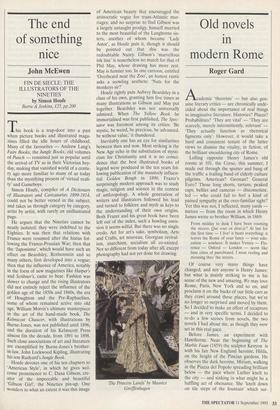The end of something nice
John McEwen
FIN DE SIECLE: THE ILLUSTRATORS OF THE NINETIES by Simon Houfe Barrie & Jenkins, f.35, pp.200 This book is a trap-door into a past when picture books and illustrated maga- zines filled the idle hours of childhood. Many of the favourites — Andrew Lang's Fairy Books, the Jungle Books, old volumes of Punch — remained just as popular until the arrival of TV as in their Victorian hey- day, making that vanished world of a centu- ry ago more familiar to many of us today than the mystifying present of 'virtual reali- ty' and Gameboys.
Simon Houfe, compiler of A Dictionary of Illustrators and Caricaturists. 1899-1914, could not be better versed in the subject; and takes us through category by category, artist by artist, with rarely an unillustrated page.
He argues that the Nineties cannot be neatly isolated; they were indebted to the Eighties. It was then that relations with France were resumed after the hiatus fol- lowing the Franco-Prussian War; then that the `Japonisme', which would have such an effect on Beardsley, Rothenstein and so many others, first developed into a vogue; then that the influence of America, notably in the form of new magazines like Harper's and Scribner's, came to bear. Fashion was slower to change and the rising illustrators did not entirely reject the influence of the golden age of the 1850s and 1860s, the era of Houghton and the Pre-Raphaelites, some of whom remained active into old age, William Morris's ultimate masterpiece in the art of the hand-made book, The Kelmscott Chaucer, with illustrations by Burne-Jones, was not published until 1896: and the duration of his Kelmscott Press almost fits the decade, from 1891 to 1898. Such close associations of art and literature are exemplified by Burne-Jones's brother- in-law, John Lockwood Kipling, illustrating his son Rudyard's Jungle Book.
Houfe devotes one of his ten chapters to `American Style', in which he gives wel- come prominence to C. Dana Gibson, cre- ator of the impeccable and beautiful `Gibson Girl', the Nineties pin-up. One wonders to what an extent it was this image of American beauty that encouraged the aristocratic vogue for trans-Atlantic mar- riages; and no surprise to find Gibson was a largely untaught prodigy, himself married to the most beautiful of the Langhorne sis- ters, another of whom became 'Lady Astor', as Houfe puts it, though it should be pointed out that this was the redoubtable Nancy. Gibson's 'marvellous ink line' is nonetheless no match for that of Phil May, whose drawing has more zest. May is funnier too. In one cartoon, entitled `Overheard near the Zoo', an honest rustic asks a scowling aesthete: 'Nuts for the monkeys sir?'
Houfe rightly puts Aubrey Beardsley in a class of his own, granting him five times as many illustrations as Gibson and May put together. Beardsley was not universally admired. When The Yellow Book he immortalised was first published, The Spec- tator was foremost among its critics: 'Be mystic, be weird, be precious, be advanced, be without value,' it thundered.
Inevitably one has an eye for similarities between then and now. Most striking is the New Age echo in the substitution of mysti- cism for Christianity and it is no coinci- dence that the best illustrated books of legend were produced in the ten years fol- lowing publication of the massively influen- tial Golden Bough in 1890. Frazer's surprisingly modern approach was to study magic, religion and science in the context of anthropology. A whole generation of writers and illustrators followed his lead and turned to folklore and myth as keys to the understanding of their own origins. Both Frazer and his great book have been left out of the index, such a howling omis- sion it seems wilful. But there was no single credo. Art for art's sake, symbolism, Arts and Crafts, art nouveau, Georgian revival- ism, anarchism, socialism all co-existed. Not so different from today after all, except photography had not yet done for drawing.
The Princess Lands' by Maurice Greiffenhagen


















































 Previous page
Previous page